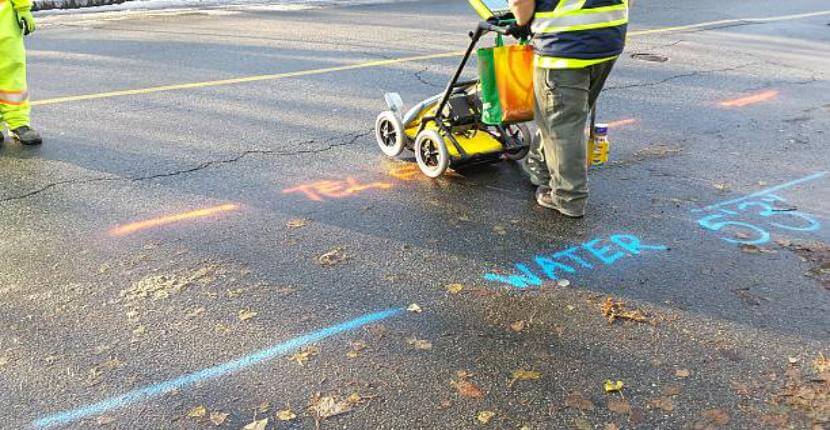
Utility Detection in Hampshire
Enquire Today For A Free No Obligation Quote
At Utility Detection, we help construction teams, engineers, and developers in Hampshire and across the UK avoid costly and dangerous mistakes by locating underground services before work begins.
Our utility detection services in Hampshire identify the presence and position of gas pipes, electric cables, telecoms, water mains, and more, allowing you to dig with confidence, avoid strikes, and stay compliant with industry regulations. Whether you’re planning a major development or a local excavation, we deliver clarity below ground.
What Is Utility Detection And Why Is It Important?
Utility detection in Hampshire is the process of identifying and locating underground utilities such as electricity cables, gas lines, water pipes, and fibre optic networks. it’s a critical step in any project involving excavation, groundworks, or site clearance.
Without detection, contractors risk hitting live services, causing injuries, service outages, environmental harm, and project delays. Detection helps in Hampshire manage that risk and ensures compliance with health and safety and CDM regulations.
What Types Of Utilities Can Be Detected Underground?
Utility detection in Hampshire identifies the following underground infrastructure:
- Electric power lines
- Gas mains
- Water supply pipes
- Foul water drains
- Surface water drains
- Telecommunications cables
- Broadband lines
- Fibre optic cables
When Should Utility Detection In Hampshire Be Carried Out In A Project?
Utility detection in Hampshire should be carried out before any ground-breaking activity, including trenching, piling, borehole drilling, and demolition.
Utility detection must form part of the pre-construction or enabling works phase so that designs and risk assessments are based on accurate utility data.
Utility detection is also performed during live construction when reactive or emergency surveys are required due to unexpected site conditions in Hampshire.
How Much Does Utility Detection Cost in Hampshire?
Costs for utility detection in Hampshire range from £400 to £2,000, depending on the site size, depth of scan, number of utility types being traced, and the technology required.
More advanced scanning, such as 3D GPR mapping or PAS 128-compliant outputs, may increase the cost. Prices also vary by region, access limitations, and whether you need rapid turnaround reporting or additional data formats like CAD or GIS files.
Contact Utility Detection in Hampshire to get customised prices for utility detection services on your construction area.
What Technologies Are Used In Utility Detection In Hampshire?
Utility detection in Hampshire requires Ground Penetrating Radar (GPR), which uses radar waves to identify utility structures beneath the surface, and Electromagnetic Location (EML), which traces conductive materials like electric cables and metal pipes.
These tools are often integrated with GPS or GNSS for precise mapping and verification. In complex sites in Hampshire, we may deploy multi-frequency radar arrays or mobile mapping systems for enhanced detection capability.
What’s The Difference Between Utility Detection And Utility Surveying?
While utility detection in Hampshire focuses on the real-time location of buried services, utility surveying goes further by producing verified maps and reports.
Detection is often a live on-site activity in Hampshire to guide safe excavation, while surveying produces compliance documents for design, planning, or health and safety audits.
In Hampshire, How Accurate Is Utility Detection And What Affects Accuracy?
Accuracy of utility detection in Hampshire depends on soil type, surface conditions, depth of the utility, and the presence of obstacles or interference like rebar or street furniture.
In good conditions, detection can be accurate to within 5–10 centimetres, but deeper utilities or congested service corridors may reduce precision.
Who Needs Utility Detection Services in Hampshire?
Utility detection services in Hampshire are essential for:
- Construction contractors – To avoid damaging buried services during excavation.
- Civil engineering firms – For accurate site planning and service coordination.
- Infrastructure developers – To identify existing underground utilities before works begin.
- Local government and authorities – For managing public works and utility maintenance.
- Telecommunications companies – To locate ducts, cables, and conduits.
- Utility service providers – For asset management and safe upgrade works.
- Land and building surveyors – To inform topographical and site surveys.
- Planning and development consultants – For feasibility and risk assessment.
- Brownfield site projects – To identify legacy infrastructure before redevelopment.
- Highway and urban redevelopment teams – To prevent service strikes in busy environments.
What Standards Govern Utility Detection And Reporting In Hampshire?
In the UK, utility detection is guided by PAS 128, which sets best practices and quality levels (from QL-D to QL-A) for underground mapping. Other regions follow AS5488 (Australia) or local authority frameworks.
Contact Utility Detection in Hampshire to get compliant, safe and methodical utility detection services.
Find More Info
Make sure you contact us today for a number of great utility detection services in South East.
Here are some towns we cover near Hampshire
Basingstoke, Tadley, Alton, BarkingFor more information on utility detection in Hampshire , fill in the contact form below to receive a free quote today.
★★★★★
“Impressed by their precision and speed. The utility detection survey helped us avoid costly delays during groundwork.”
Kieran Blatchford
Hampshire
★★★★★
“Top-notch service from start to finish. They mapped out buried utilities with accuracy, saving our project from major risks.”
Lucinda Prentice
Hampshire